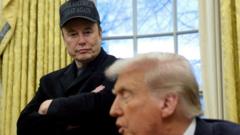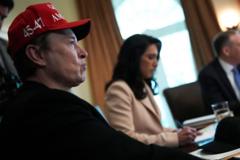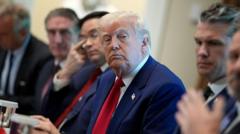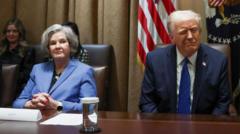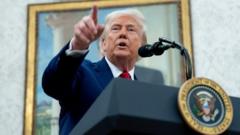The Court of International Trade's ruling not only undermines President Trump's tariff strategy but might reshape the future of US trade regulations as legal battles unfold.
Court Ruling Halts Trump's Tariffs: What Lies Ahead?
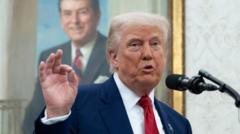
Court Ruling Halts Trump's Tariffs: What Lies Ahead?
US federal court decision impacts trade policy and economic landscape.
The recent ruling by the US Court of International Trade has delivered a significant blow to President Donald Trump's tariff policies, which have been a cornerstone of his economic strategy. The Manhattan court determined that the emergency law the White House invoked does not grant the president the authority to impose extensive tariffs on various nations. Instead, it stated that the US Constitution delegates such powers to Congress, thereby restricting the president's unilateral actions to safeguard economic interests.
In the wake of this decision, the Trump administration swiftly filed an appeal. This legal challenge originated from the nonpartisan Liberty Justice Center, representing five small businesses adversely affected by the tariffs. The court ruled against the application of the International Emergency Economic Powers Act (IEEPA), a law from 1977 that the Trump administration had relied upon to justify these tariffs.
Moreover, the court's decision extends to other levies imposed on key trading partners, including China, Mexico, and Canada, which had been enacted in response to perceived national security threats linked to drug trafficking and immigration. However, tariffs specifically targeting certain products such as vehicles and steel remain untouched as they fall under different legal statutes.
The ruling has been met with mixed reactions. While the White House criticized the court's decision, arguing that it undermines the president's ability to handle national emergencies, state officials like New York's Attorney General Letitia James welcomed the outcome as a check on executive power. James articulated that these tariffs represented an undue tax burden on American families and businesses and could have exacerbated economic issues across the country.
Financial markets responded positively to the announcement, with stock indices in Asia showing gains and US futures jumping, reflecting investor relief following turbulent trade negotiations. According to analysts, the ruling signals a pivotal shift away from executive-led trade policies towards a more institutional-based approach.
Looking ahead, the administration has a ten-day window to position the tariffs as the case progresses through the appeals process. If the appeal fails, the US Customs and Border Protection Agency is expected to act in accordance with the court's ruling, potentially leading to refunds of previously paid tariffs plus accrued interest. This would particularly affect the reciprocal tariffs that had been drastically increased on Chinese goods.
Trade tensions that had arisen over the past months saw the president initially impose a blanket 10% tariff on most international trading partners, with steeper rates applied in certain circumstances. Ongoing negotiations and backtracking on tariffs with both China and the EU have further complicated the trade landscape, showcasing the volatility and fluidity of Trump's tariff policies.
The road ahead remains uncertain as the administration navigates the implications of the court's ruling, which some experts interpret as a crucial moment for limiting presidential overreach in trade matters. The interaction between executive power and Congressional authority will likely continue to shape discussions surrounding future trade policies in the US.
In the wake of this decision, the Trump administration swiftly filed an appeal. This legal challenge originated from the nonpartisan Liberty Justice Center, representing five small businesses adversely affected by the tariffs. The court ruled against the application of the International Emergency Economic Powers Act (IEEPA), a law from 1977 that the Trump administration had relied upon to justify these tariffs.
Moreover, the court's decision extends to other levies imposed on key trading partners, including China, Mexico, and Canada, which had been enacted in response to perceived national security threats linked to drug trafficking and immigration. However, tariffs specifically targeting certain products such as vehicles and steel remain untouched as they fall under different legal statutes.
The ruling has been met with mixed reactions. While the White House criticized the court's decision, arguing that it undermines the president's ability to handle national emergencies, state officials like New York's Attorney General Letitia James welcomed the outcome as a check on executive power. James articulated that these tariffs represented an undue tax burden on American families and businesses and could have exacerbated economic issues across the country.
Financial markets responded positively to the announcement, with stock indices in Asia showing gains and US futures jumping, reflecting investor relief following turbulent trade negotiations. According to analysts, the ruling signals a pivotal shift away from executive-led trade policies towards a more institutional-based approach.
Looking ahead, the administration has a ten-day window to position the tariffs as the case progresses through the appeals process. If the appeal fails, the US Customs and Border Protection Agency is expected to act in accordance with the court's ruling, potentially leading to refunds of previously paid tariffs plus accrued interest. This would particularly affect the reciprocal tariffs that had been drastically increased on Chinese goods.
Trade tensions that had arisen over the past months saw the president initially impose a blanket 10% tariff on most international trading partners, with steeper rates applied in certain circumstances. Ongoing negotiations and backtracking on tariffs with both China and the EU have further complicated the trade landscape, showcasing the volatility and fluidity of Trump's tariff policies.
The road ahead remains uncertain as the administration navigates the implications of the court's ruling, which some experts interpret as a crucial moment for limiting presidential overreach in trade matters. The interaction between executive power and Congressional authority will likely continue to shape discussions surrounding future trade policies in the US.


